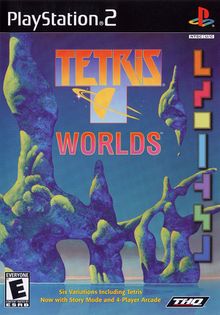Tetris Worlds: Difference between revisions
No edit summary |
|||
| Line 44: | Line 44: | ||
| T-spin triple || 6 | | T-spin triple || 6 | ||
|} | |} | ||
This is the triangular goal system (5/10/15/20/25/30/35/40/45/50/55/60/65/70/75). | |||
== Square mode == | == Square mode == | ||
Revision as of 18:25, 24 January 2020
| Tetris Worlds | |
|---|---|
 PS2 boxart by Roger Dean | |
| Developer(s) | Blue Planet Software (PC, PS2), Radical Entertainment (GC, Xbox), 3d6 Games (GBA) |
| Publisher(s) | THQ, Success |
| Platform(s) | Game Boy Advance, GameCube, PlayStation 2, Windows, Xbox |
| Release | Game Boy Advance
|
| Gameplay info | |
| Next pieces | 3 (GBA), 6 (other) |
| Playfield size | 10 × 22 |
| Hold piece | Yes |
| Hard drop | Yes |
| Rotation system | SRS |
Tetris Worlds was the game that became the basis for the Tetris Guideline.
Like other Guideline games, Tetris Worlds has a relatively long lock delay with infinity, a hard drop without lock delay, and full SRS. It shows three next pieces on GBA and six next pieces on other platforms. Unlike later games, the game had an autorepeat feature for the rotation button; holding down the rotation key kept the piece spinning continually.
Tetris mode
Classic game with then newly standardized SRS.
Goal of each level L is to earn 5*L points:
| Line clear | Score |
|---|---|
| Single | 1 |
| Double | 3 |
| Triple | 5 |
| Tetris | 8 |
| Tetris B2B | 12 |
| T-spin zero | 1 |
| T-spin single | 3 |
| T-spin double | 7 |
| T-spin triple | 6 |
This is the triangular goal system (5/10/15/20/25/30/35/40/45/50/55/60/65/70/75).
Square mode
Much the same as The New Tetris (which see), except Tetris Worlds has a longer lock delay, no lock delay on hard drop instead of firm drop, full SRS, and (on platforms other than GBA) five next pieces.
Goal of each level L is to earn 10*L points:
| Line clear | Score |
|---|---|
| Single | 1 |
| Double | 3 |
| Triple | 5 |
| Tetris | 8 |
| 4x4 squares | See TNT |
| T-spin zero | 1 |
| T-spin single | 3 |
| T-spin double | 7 |
| T-spin triple | 6 |
- T-spin line clear causes avalanche, just as in The New Tetris, except using SRS T-spin rules
- Extra lines after a T-spin avalanche: not determined
Cascade mode
Nearly identical to the fan game Quadra. After a line is cleared, each tetromino falls as a separate piece under the influence of gravity, and it is possible for pieces to fall and fill in gaps, creating a cascade.
Goal of each level L is to earn 5*L points. The score for each step n of a cascade, where n = 1 to 20, and L lines are cleared:
- (L + n) * 2 - 3
For example, a tetris-double-single combo scores
- (4 + 1) * 2 - 3 = 7 on first step
- (2 + 2) * 2 - 3 = 5 on second step
- (1 + 3) * 2 - 3 = 5 on third step
for a total of 17 points.
Tip: This mode is easier than standard Tetris. S and Z cascade makes it easier still.
Hotline mode
|
Rows 5, 10, 14, 17, 19, and 20 (counting from the bottom up) are highlighted. Only lines cleared in these rows are counted toward the score. 10% of tetrominoes are multi-colored, and it has cascade mode's gravity.
Goal of each level L is to earn 5*L points:
| Row | Points |
|---|---|
| 5 | 1 |
| 10 | 2 |
| 14 | 3 |
| 17 | 4 |
| 19 | 5 |
| 20 | 6 |
The line clear with the highest possible score is a tetris or hurdle in 17, 19, and 20, for a total of 15 points.
So it's best to create a bit of intentional garbage to boost your stack to the higher-scoring top of the field.
Sticky mode
Much the same as The Next Tetris. 20% of tetrominoes are multi-colored and break into smaller pieces of separate colors when they lock. Blocks of the same color glue themselves together; any contiguous group of the same color with 25 or more blocks disappears (an event referred to as a "Critical Mass"). Anything with nothing supporting it falls, just as in Cascade mode.
Each level L starts with L + 1 rows of floating garbage on the screen, and the goal of each level is to clear the bottom line of garbage.
Fusion mode
Tetrominoes and single, distinctive "atom" blocks fall. There are 3 atom blocks in every (bag of) 10 pieces.
Clearing a line containing an atom block will remove all blocks in the line except atom blocks, and it will cause a cascade on all rows of and above the atom block. Each level L starts with L + 1 rows of floating garbage on the screen, and the goal of each level L is to connect 2*L atom blocks to the "Fusion" block initially located in one of the bottom corners of the playfield.
Gravity
All game modes have identical gravity curves. The gravity is entirely determined by the player's current level. The game uses the following formula to determine the time spent per row, in seconds:
Time = (0.8-((Level-1)*0.007))(Level-1)
Though the values produced by this formula have a huge number of decimal places, the following approximate G values retain frame-accuracy and are therefore indistinguishable from the formula.
| Level | Speed (unit: G) |
|---|---|
| 1 | 0.01667 |
| 2 | 0.021017 |
| 3 | 0.026977 |
| 4 | 0.035256 |
| 5 | 0.04693 |
| 6 | 0.06361 |
| 7 | 0.0879 |
| 8 | 0.1236 |
| 9 | 0.1775 |
| 10 | 0.2598 |
| 11 | 0.388 |
| 12 | 0.59 |
| 13 | 0.92 |
| 14 | 1.46 |
| 15 | 2.36 |
The same speed formula would be used in other Tetris Guideline games.
External links
- Discussion in the forum about unlocking various hidden gameplay modes, as well as the format and editing of the "TWS" script files used in the PC version of Tetris Worlds (Wiki article here: Tetris Worlds for PC Anomalies and Hacks )
- Manual (Xbox version)
| ||||||||||||||

